Transportation Network Companies (TNCs) have been one of the most defining shifts in our mobility ecosystem in the last decade. Although they offer benefits like affordability, an on-demand model, and reduced DWIs—there are drawbacks to the ways TNCs currently operate.
There is no denying that Transportation Network Companies (TNCs) like Uber and Lyft have fundamentally changed the way that we travel within—and even between—cities. The emergence and rise of ride-hailing throughout this decade has been a defining shift in our modern mobility ecosystem.
Riders in bustling metropolitan areas now have access to a slew of personalized, on-demand transportation options. The relatively low cost of riding has created a sustainable model for riders, but threatens the stability of a career as a contracted driver and has posed some concerns about profitability at the corporate level.
One of the core challenges facing TNCs and the cities they inhabit is the 2.8x ratio of miles driven in TNCs compared to personal vehicles. Why? According to a 2019 PwC report, TNC drivers spend an estimated 20-50% of their miles traveled without a passenger in the car, either waiting for a ride request, idling while they await a passenger, or navigating to the next rider. Taking up increasingly valuable road space, these added miles driven contribute to congestion, speed up the depreciation of vehicles and city roads, and increase gas usage, which is both a financial and environmental cost.
From offering low-cost transportation options to reducing DWI deaths, there is no doubt that TNCs pose benefits for cities. However, in order for them to continue functioning in the urban transportation model in a way that is functional and sustainable, TNCs need to reduce the inefficiencies associated with idling, inconvenient drop-off and pick-up points, and time spent without passengers.
Where can TNCs find a solution to these challenges within dense urban areas? The answer lies in a much older facet of the same transportation environment: parking garages. Traditional garages are uniquely qualified to serve the needs of TNCs for a few key reasons:
- Parking garages are most populous in the same urban areas where Uber and Lyft drop offs and pick ups are concentrated
- They are easy to navigate to and access by car or foot
- There is abundant space for vehicles to stage as well as for other services to be introduced
FlashParking believes that relationships between traditional mobility players like parking garages and more recent market entrants like TNCs will drive the mobility revolution forward. By partnering with TNCs to offer them conveniently-located passenger interception locations as well as staging between rides, garages can remedy the societal challenges that have emerged with TNCs.
In order to realistically serve these needs, garages simply need to implement the technological infrastructure to support interactions in a way that is seamless, efficient, and logical. By establishing a strategic partnership, garages and TNCs can establish mutually-beneficial economic efficiencies with cost and time savings, while also improving societal well-being through reductions in pollution and congestion.
Byline: Miranda Waldron Curry, Product Marketing Specialist, Miranda.WaldronCurry@flashparking.com
FlashParking is a leader in parking and mobility solutions that address some of the most complex transportation problems facing urban societies. Founded in 2011 with a simple mission to perfect the parking experience at valet and parking access and revenue control (PARCS) operations, FlashParking has grown to serve thousands of site-level operations, enterprise portfolios, and smart cities nationwide. By establishing future-ready infrastructures, delivering unrivaled cloud intelligence, and designing world-class customer experiences, FlashParking is powering the evolution from traditional parking assets to next-generation mobility hubs.
For more information on the FlashMobilityHub—a future-ready solution for cities, owners, and operators to evolve into the new mobility ecosystem—visit: www.flashparking.com/mobility/

